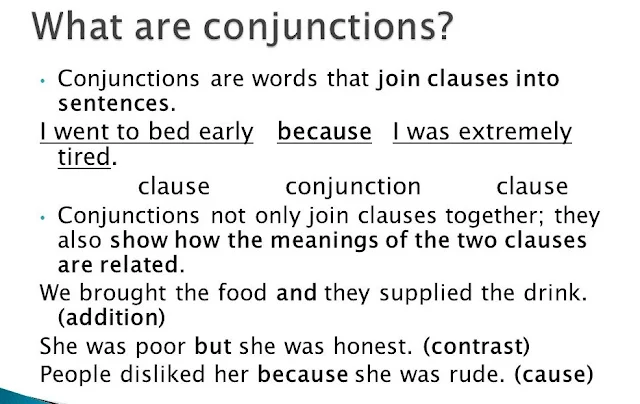What Are Conjunctions?
What Are Conjunctions?
Conjunctions are used to join words or groups of words together. The word conjunction comes from the Latin conjuntio, which means conjoin. Many words are classified as conjunctions, but the following three are the most common conjunctions by far:- and
- but
- or
Types of Conjunctions
Conjunctions can be categorized into one of three groupings:Coordinating Conjunctions
Coordinating conjunctions are the ones that spring to mind when people think about conjunctions. They include:- and
- but
- or
- nor
- for
- so
- yet
Coordinating Conjunctions Joining Individual Words:
- Jamie, Adam, and Lee arranged to meet by The Bull at 7 o'clock.
- It is a small but practical kitchen.
- The finance manager or his new deputy from Holland will notify you when the report is ready to send.
- John or his new deputy from Holland will notify you when the report is ready to send.
- A little sincerity is a dangerous thing, and a great deal of it is absolutely
fatal.(Oscar Wilde)
(Here, the conjunction and joins two independent clauses.) - We are all in the gutter, but some of us are looking at the stars.
(Oscar Wilde)
- History will be kind to me, for I intend to write it.
(Winston Churchill)
Correlative Conjunctions
Correlative conjunctions appear in pairs. They include:- either...or
- neither...nor
- whether...or
- not only...but also
- This man is either dead or my watch has stopped.
(Groucho Marx)
Subordinating Conjunctions
Subordinating conjunctions include:- after
- although
- as
- because
- before
- if
- once
- since
- than
- that
- though
- till
- until
- when
- where
- whether
- while
- Keep your hand on the wound until the nurse asks you to take it off.
- Personally I'm always ready to learn, although I do not always like being taught. Sir Winston Churchill (1874-1965)
- We can't all be heroes because somebody has to sit on the curb and clap as they go by. Will Rogers (1879-1935)
Common Errors with Conjunctions
Conjunctions do not normally cause serious errors, but writers are sometimes confused about when to place a comma before a conjunction. Unfortunately, there is no simple rule, such as: Never put a comma before and.The guidelines are explained in the lesson Conjunctions and Commas.
Comma before And in a List?
Most lists look like this:- Thing, another thing, another thing, and the final thing.
When there are just two list items, there is no need for a comma before the conjunction. For example:
- Thing and the final thing. (No comma is required because it is a list containing just two list items.)
- I know George and Toby. (No comma required before the and.)
However, when there are more than two list items, the world is divided on whether there should be a comma. There is no right answer. You have to pick a convention and stick with it.
The comma before the conjunction is called an Oxford Comma. Some people consider the Oxford Comma to be a waste of ink, while others strongly campaign for its inclusion. In general terms, the Oxford Comma is more common in the US than it is in the UK (despite it being called the Oxford Comma).
| Followers of the Oxford Comma (generally Americans) | Avoiders of the Oxford Comma (generally Brits) |
|---|---|
|
|
There is another quirk. On occasion, it may be appropriate to use a comma with the conjunction in a simple list (even a list with just two list items). This could be for the sake of tidiness or to eliminate ambiguity. For example:
- The news will be shown after Dangermouse, and Rug Rats.
- The train will stop at Harrow, Pinner, Watford, and Bushey.
- The emblem is an amalgamation of the British and Irish flags, the Stars and Stripes, andthe Hammer and Sickle.
Related Page:













No comments